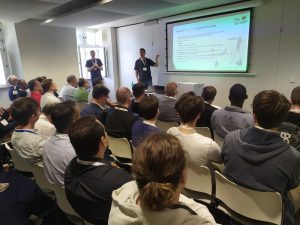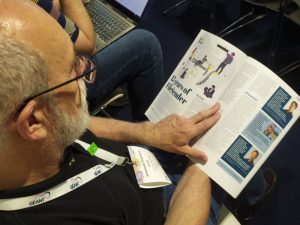40 representatives of 24 organizations (including 19 NRENs) from 19 countries participated in the annual NREN FileSender meeting at TNC24 in Rennes, France, held on June 12, 2024. Here, FileSender community enthusiasts – service providers, users and developers – met to exchange their experiences, share expectations and discuss priorities for the future.
With 2024 being the 15th anniversary of FileSender, this year’s gathering was also a celebration, and thus a perfect opportunity to look back and reflect on the previous development, decisions made and achievements, new challenges and next steps.
FileSender aims to be a widely deployed service enabling anyone to easily and securely transfer files of any size from any person or machine to any other person or machine. FileSender explicitly targets mass usage and is built to service the 99% of users who would rather spend their time on other things than figuring out how to perform large file transfers.
The FileSender Board, comprising Jan Meijer of Sikt, the Norwegian NREN, Guido Aben of SUNET, the Swedish NREN, and Rogier Spoor of SURF, the Dutch NREN, provided an overview of FileSender and the team behind it. Highlights were the latest implementation of the new user interface (UI) which aims to improve user experience (UX); the 2024 update on deployments in NREN space; how a FileSender service features as part of the EOSC EU Node; and the status of finances and contributor contracts.
Currently, active contribution agreements are in place with several NRENs: AARNet (Australia), ACOnet (Austria), CSC (Finland), DeiC (Denmark), GARR (Italy), HEAnet (Ireland) and Switch (Switzerland).
The current roadmap was introduced, with plans to continue the UI redesign process. Last year Marleen Velthuis, a UX expert involved with the project, created a so-called wireframe as the basis for the new UI, which has been implemented by the excellent work of RNP, the Brazilian NREN. In a next iteration, Marleen has recently made some optimisations such as accessibility (e.g., contrasting colours) and user-friendliness (e.g., consistency around buttons, font, etc.), and she has reduced the transfer flow to require fewer steps.
The public release of FileSender version 3.0 is drawing closer. As this represents a release with rather major changes, it is vitally important to conduct full-system security audits. These security audits have been performed and the results were presented during the meeting. The FileSender Board emphasized the importance of doing such regular audits on the FileSender product, to be able to identify security issues as early as possible. This priority was vocally appreciated and mirrored by the meeting attendees.
During this meeting, the concept of an NREN FileSender federation was discussed. The concept is to present the collective of known FileSender deployments as an organisationally coherent R&E file transfer infrastructure, as opposed to a collection of unrelated dot points. If such a federation were in place, it could facilitate future collective efforts: to simplify service delivery, to coordinate security responses, to conduct policy alignment (e.g., minimum security baseline), to deliver aggregated statistics of total use of infrastructure, etc.
The encouraging progress laid out above happens when individuals and organisations are willing to contribute their time and resources. If you think this work is valuable, please contribute to the FileSender development financially or in-kind by contacting the FileSender Board. Presently, pertinent pressures are around sustainable funding and the FileSender federation. If someone were available to work on attracting more funding to ensure continuous development and long-term sustainability, or could pull the project management need of fostering the creation of the NREN FileSender federation to benefit the global R&E community, that would be particularly helpful.





